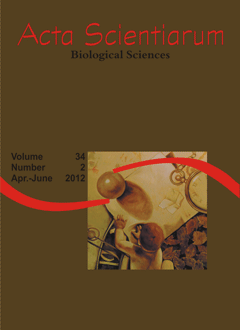<b>Microbiological water quality and gill histopathology of fish from fish farming in Itapecuru-Mirim County, Maranhão State</b> - doi: 10.4025/actascibiolsci.v34i2.8460
Resumo
The present study evaluated the microbiological water quality and tissue lesions in gills from Nile tilapia (Oreochromis niloticus) and hybrid tambacu (Colossoma macropomum female x Piaractus mesopotamicus male). For this, water and gills were collected from fish farming at six locations in Itapecuru-Mirim County, Maranhão State. Microbiological water analyses revealed contamination by total coliforms, Escherichia coli and heterotrophic bacteria. In the gills, we observed a diversity of Gram-positive and Gram-negative bacteria. The tissue lesions were: lamellar fusion, interlamellar hyperplasia, sub-epithelial edema and telangiectasia. Inflammatory lesions were not observed. Significant statistical difference (p > 0.05) was not detected when comparing different gills lesions during rainy and dry season. The correlation between lesion and pond type was statistically different (p < 0.05) for lamellar fusion and interlamellar hyperplasia which occurred more frequently at ground ponds. Regarding the frequency of lesions in the different fish species, there was statistical difference (p < 0.05), and the tambacu was more sensitive to lamellar fusion while tilapia was more sensitive for the other lesions. In relation to the sampling stations, there was statistical difference for all the gill lesions. In conclusion, tissue lesions are nonspecific and function as a defense mechanism against polluted aquatic environments, without infectious character.
Downloads
DECLARAÇÃO DE ORIGINALIDADE E DIREITOS AUTORAIS
Declaro que o presente artigo é original, não tendo sido submetido à publicação em qualquer outro periódico nacional ou internacional, quer seja em parte ou em sua totalidade.
Os direitos autorais pertencem exclusivamente aos autores. Os direitos de licenciamento utilizados pelo periódico é a licença Creative Commons Attribution 4.0 (CC BY 4.0): são permitidos o compartilhamento (cópia e distribuição do material em qualqer meio ou formato) e adaptação (remix, transformação e criação de material a partir do conteúdo assim licenciado para quaisquer fins, inclusive comerciais.
Recomenda-se a leitura desse link para maiores informações sobre o tema: fornecimento de créditos e referências de forma correta, entre outros detalhes cruciais para uso adequado do material licenciado.












1.png)




3.png)













